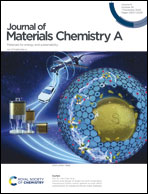An advanced and applicable heat-resistant explosive through controllable regiochemical modulation†
Abstract
Since the demands for the thermostability of energetic materials have risen in the deep mining and aerospace industries, the research on heat-resistant explosives with remarkable thermal stability as well as high energy has always been a tough challenge. Here we present the synthesis and properties of an advanced heat-resistant explosive 5,5′-bis(3,5-dinitro-1H-pyrazol-4-yl)-1H,1′H-3,3′-bi(1,2,4-triazole) (BDBT-2). This compound exhibits a striking thermal decomposition temperature of 372 °C, a high detonation velocity of 8705 m s−1, desirable sensitivity properties, and is easy to scale-up. These impressive properties and energetic performance of BDBT-2 surpass those of the current and industrially used heat-resistant explosive 2,2′,4,4′,6,6′-hexanitrostilbene (HNS) and the recently reported thermostable explosives, strongly supporting BDBT-2 as a candidate for advanced heat-resistant explosives. Moreover, a comprehensive comparison between regioisomers 5,5′-bis(3,4-dinitro-1H-pyrazol-5-yl)-2H,2′H-3,3′-bi(1,2,4-triazole) (BDBT-1) and BDBT-2 suggests that regiochemical modulation will have broad prospects in the development of advanced heat-resistant explosives.



 Please wait while we load your content...
Please wait while we load your content...